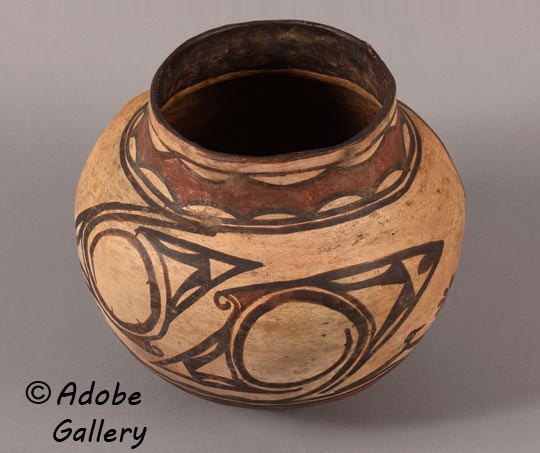Hopi Classic Nineteenth Century Polacca Polychrome Jar [SOLD]
+ Add to my watchlist Forward to Friend
- Category: Historic
- Origin: Hopi Pueblo, Hopituh Shi-nu-mu
- Medium: clay, pigment
- Size: 9-¾” height x 10-½” diameter
- Item # C4815D SOLD
This magnificent jar originated on the Hopi mesas during the period 1860-1890, a period for which a designation has been assigned of "Polacca Polychrome" pottery. It is of the earlier style from this period, likely 1865-1875. It is in incredible condition with no repairs or overpainting.
During the years of the Pueblo Revolt, a new style of pottery called Payupki Polychrome became dominant. It was influenced heavily by 17th- and 18th-century New Mexico pueblo ceramics. In the 1780s, a style of white-slipped pottery evolved which is now designated as Polacca Polychrome (1780-1900), which included elements from Payupki Polychrome, Acoma and Zuni Pueblos, and Spanish ceramics. For this presentation, we are interested in the period of Polacca Polychrome between 1860-1890. From the 1860s, Zuni forms and designs began to dominate. Decorations include rainbird volutes, birds, and flowers as vividly illustrated on the jar in this presentation.
This Zuni influence may have resulted from the forced migration of the Hopi to Zuni during a period of severe droughts and epidemics. Undecorated space is abundant in jars of this period, as the emphasis was on the painted designs. The red rims were now painted black, and the white slip was more granular than found in earlier pottery. The layout consisted of two large panels of Zuni volute designs representing the rainbird.
One would expect that the relative isolation of the Hopi mesas would have precluded outside influence on its pottery, but there was a strong influence from the Tewa- and Keres-speaking pueblos and Zuni Pueblo on Polacca Polychrome between 1780 and 1860.
Polacca Polychrome pottery, of which this jar is an example, exhibits Zuni designs such as the curvilinear spiral "rainbird" motif, which dominates the body of the vessel The rainbird design is presented in pairs on opposing sides of the jar. Additional designs include a series of birds resting near the bottom of the design area and incorporated into the framing line. There are two flowers on opposite sides of the jar as well. On Zuni jars, such flowers have matured into a large medallion, representing sunflowers or the flower on the Salimopia katsina face. The black outlined red design around the neck contains the largest amount of red in the overall design.
Differing from Zuni pottery of the period, this jar has a rounded underbody and a wiped-on red slip on the underbody. Traditional Polacca Polychrome jars are smaller than other pueblo water jars, leaving one to describe this jar as a small storage jar. The rounded underbody is another indication that this jar is not one to hold water, but one for storage of non-liquid goods.

In defense of the appearance of the Zuni rainbird designs on this jar, we must recall that on more than one occasion, Hopi people moved en masse to Zuni in the 19th century to escape the contagious diseases introduced by outsiders which ravished members of the villages of First and Second Mesas. This exile of large numbers of Hopi to Zuni lasted for decades, introducing the new arrivals to Zuni ceramics and traditions. This exile resulted in many mixed marriages of Hopi and Zuni. When the Hopi returned to their home villages, they took with them the influences experienced at Zuni.
Condition: very good condition
Provenance:
- this Hopi Classic Nineteenth Century Polacca Polychrome Jar is from the collection of a client of Adobe Gallery.
- previously the estate of Alicia Irvine, III (deceased 1947), Denver, Colorado, inherited from her mother who was a close friend of fellow collector Ivey Peabody, daughter of George Peabody, the prominent philanthropist who established the Peabody Museum at Harvard University. Alicia Irvine and Ivey Peabody traveled to the Southwest in the 1880s and collected widely from the Indians.
Reference: Wade, Edwin L. and Allan Cooke. Canvas of Clay: Seven Centuries of Hopi Ceramic Art. El Otro Lado, Sedona. 2012. "Part One: Seven Centuries of Hopi Ceramics" by Allen Cooke.
TAGS: Nampeyo of Hano, Pottery, Hopi Pueblo, Zuni Pueblo, Acoma Pueblo

- Category: Historic
- Origin: Hopi Pueblo, Hopituh Shi-nu-mu
- Medium: clay, pigment
- Size: 9-¾” height x 10-½” diameter
- Item # C4815D SOLD



